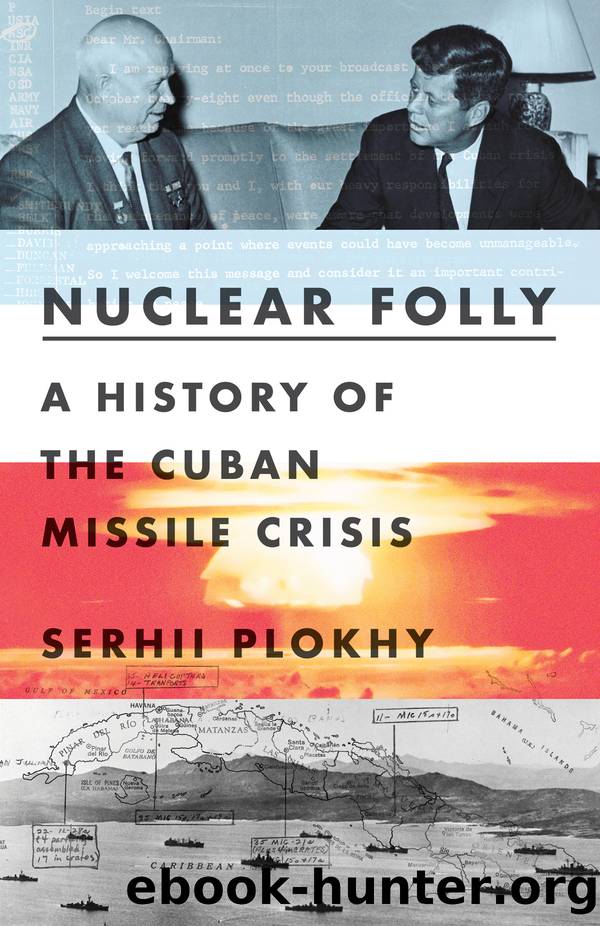Nuclear Folly by Serhii Plokhy

Author:Serhii Plokhy [Plokhy, Serhii]
Language: eng
Format: epub
Published: 2021-03-03T00:00:00+00:00
19
âTARGET DESTROYED!â
By the morning of October 27, few people in the Cuban leadership or among the Soviet commanders in Cuba doubted that an invasion was imminent. There was no need for spies or secret information from UN headquarters in New York or the KGB station in Washington to reach that conclusion. The evidence was right there in the sky above Cuba. It came with the noise of US Navy Vought F-8 Crusader airplanes, supersonic fighters that could also be used as bombers and surveillance planes. Since October 23 they had been crisscrossing Cuba on a regular basis, focusing on Soviet ballistic missile sites and military installations.
Operation âBlue Moon,â initiated on October 17 and implemented on October 23, involved pilots and planes from two photographic squadrons reinforced by pilots from the US Marine Corps. They flew RF-8A Crusader planes with three CAX-12 trimetrogon cameras and two K-17 vertical cameras, all manufactured by Chicago Aerial Industries. Flying 1,000 feet over their targets (as compared to the 70,000-foot altitude of the U-2s), the pilots could get close-up photos of the sites, taking approximately four frames per second, or one shot every 70 yards. The planes flew in pairs, both aircraft equipped with cameras. They would take off from Boca Chica Naval Air Station at Key West, Florida, twice a day and, after flying over their targets, often multiple times (it took them approximately four minutes to go over Cuba), return to Florida, landing at the Naval Air Station in Jacksonville. Film collected there would be sent to Andrews Air Force Base for development and then to the CIA National Interpretation Center.1
The Crusaders flew unobstructed until October 27, when Castro gave the order to start shooting at the low-flying planes. It was Crusader photographs that Adlai Stevenson used at the United Nations on October 25. Commander William Ecker, the commanding officer of VFP-62, one of the light photographic squadrons, reminisced many years later about flying over Cuba in the midst of antiaircraft fire: âYou could see the popcorn in your mirrors.â âPopcornâ meant the white puffs of antiaircraft shells bursting in the wake of the fast-moving Crusader. âBut we never got hit,â noted Ecker.
Lev Evseev, a young officer with a Soviet Air Force unit in Cuba, remembered that both automatic rifles and antiaircraft guns were used to fire at the Crusaders. After someone fired an automatic rifle at a pair of the planes flying over his airfield, recalled Evseev, âCuban anti-aircraft units, taking that as a signal, opened fire.â Evseev found an ideal vantage point to witness the event. âI quickly climbed onto a wing of my plane (it was covered) and saw shells bursting ahead, above, and below the Americans flying overhead, but again and again they failed to make a hit,â he recalled. âThe Americans made three overflights, and high-caliber machine guns were fired three times. Shrapnel from anti-aircraft shells kept falling among us. But the Americans, having carried out their mission, flew away safe and sound.â2
The unceasing Crusader overflights racked the
Download
This site does not store any files on its server. We only index and link to content provided by other sites. Please contact the content providers to delete copyright contents if any and email us, we'll remove relevant links or contents immediately.
| Anthropology | Archaeology |
| Philosophy | Politics & Government |
| Social Sciences | Sociology |
| Women's Studies |
The Secret History by Donna Tartt(16618)
The Social Justice Warrior Handbook by Lisa De Pasquale(11489)
Thirteen Reasons Why by Jay Asher(7786)
This Is How You Lose Her by Junot Diaz(5766)
Weapons of Math Destruction by Cathy O'Neil(5034)
Zero to One by Peter Thiel(4823)
The Myth of the Strong Leader by Archie Brown(4789)
Promise Me, Dad by Joe Biden(4444)
Stone's Rules by Roger Stone(4415)
Beartown by Fredrik Backman(4412)
How Democracies Die by Steven Levitsky & Daniel Ziblatt(4396)
The Fire Next Time by James Baldwin(4340)
100 Deadly Skills by Clint Emerson(4075)
A Higher Loyalty: Truth, Lies, and Leadership by James Comey(4031)
Rise and Kill First by Ronen Bergman(4012)
The David Icke Guide to the Global Conspiracy (and how to end it) by David Icke(3880)
The Farm by Tom Rob Smith(3871)
Secrecy World by Jake Bernstein(3782)
The Doomsday Machine by Daniel Ellsberg(3730)
